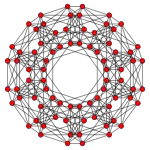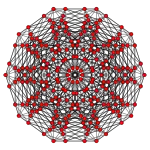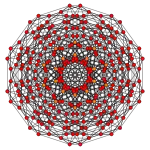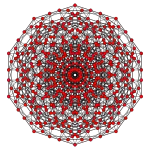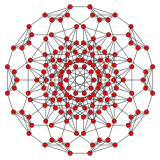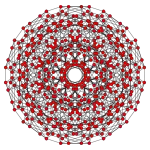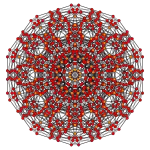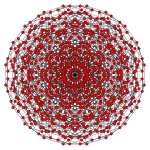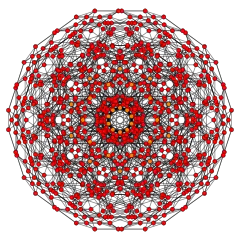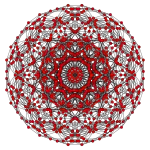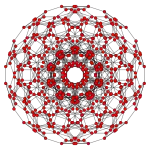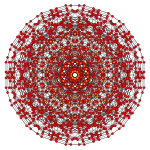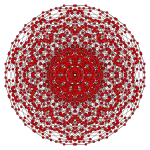Rectified 5-orthoplexes
In five-dimensional geometry, a rectified 5-orthoplex is a convex uniform 5-polytope, being a rectification of the regular 5-orthoplex.
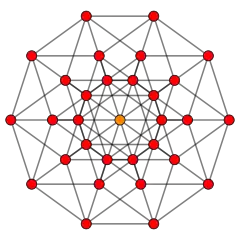 5-cube |
 Rectified 5-cube |
 Birectified 5-cube Birectified 5-orthoplex | ||
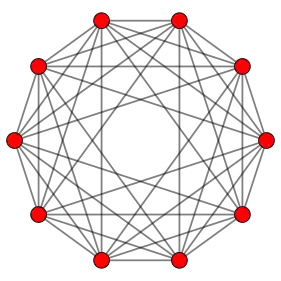 5-orthoplex |
 Rectified 5-orthoplex | |||
| Orthogonal projections in A5 Coxeter plane | ||||
|---|---|---|---|---|
There are 5 degrees of rectifications for any 5-polytope, the zeroth here being the 5-orthoplex itself, and the 4th and last being the 5-cube. Vertices of the rectified 5-orthoplex are located at the edge-centers of the 5-orthoplex. Vertices of the birectified 5-orthoplex are located in the triangular face centers of the 5-orthoplex.
Rectified 5-orthoplex
| Rectified pentacross | |
|---|---|
| Type | uniform 5-polytope |
| Schläfli symbol | t1{3,3,3,4} |
| Coxeter-Dynkin diagrams | |
| Hypercells | 42 total: 10 {3,3,4} 32 t1{3,3,3} |
| Cells | 240 total: 80 {3,4} 160 {3,3} |
| Faces | 400 total: 80+320 {3} |
| Edges | 240 |
| Vertices | 40 |
| Vertex figure | Octahedral prism |
| Petrie polygon | Decagon |
| Coxeter groups | BC5, [3,3,3,4] D5, [32,1,1] |
| Properties | convex |
Its 40 vertices represent the root vectors of the simple Lie group D5. The vertices can be seen in 3 hyperplanes, with the 10 vertices rectified 5-cells cells on opposite sides, and 20 vertices of a runcinated 5-cell passing through the center. When combined with the 10 vertices of the 5-orthoplex, these vertices represent the 50 root vectors of the B5 and C5 simple Lie groups.
E. L. Elte identified it in 1912 as a semiregular polytope, identifying it as Cr51 as a first rectification of a 5-dimensional cross polytope.
Alternate names
- rectified pentacross
- rectified triacontiditeron (32-faceted 5-polytope)
Construction
There are two Coxeter groups associated with the rectified pentacross, one with the C5 or [4,3,3,3] Coxeter group, and a lower symmetry with two copies of 16-cell facets, alternating, with the D5 or [32,1,1] Coxeter group.
Cartesian coordinates
Cartesian coordinates for the vertices of a rectified pentacross, centered at the origin, edge length are all permutations of:
- (±1,±1,0,0,0)
Images
| Coxeter plane | B5 | B4 / D5 | B3 / D4 / A2 |
|---|---|---|---|
| Graph |  |
 |
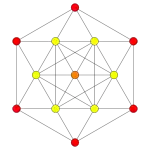 |
| Dihedral symmetry | [10] | [8] | [6] |
| Coxeter plane | B2 | A3 | |
| Graph | 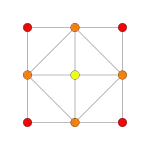 |
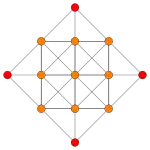 | |
| Dihedral symmetry | [4] | [4] |
Related polytopes
The rectified 5-orthoplex is the vertex figure for the 5-demicube honeycomb:






 or
or 








This polytope is one of 31 uniform 5-polytope generated from the regular 5-cube or 5-orthoplex.
Notes
References
- H.S.M. Coxeter:
- H.S.M. Coxeter, Regular Polytopes, 3rd Edition, Dover New York, 1973
- Kaleidoscopes: Selected Writings of H.S.M. Coxeter, edited by F. Arthur Sherk, Peter McMullen, Anthony C. Thompson, Asia Ivic Weiss, Wiley-Interscience Publication, 1995, ISBN 978-0-471-01003-6
- (Paper 22) H.S.M. Coxeter, Regular and Semi Regular Polytopes I, [Math. Zeit. 46 (1940) 380-407, MR 2,10]
- (Paper 23) H.S.M. Coxeter, Regular and Semi-Regular Polytopes II, [Math. Zeit. 188 (1985) 559-591]
- (Paper 24) H.S.M. Coxeter, Regular and Semi-Regular Polytopes III, [Math. Zeit. 200 (1988) 3-45]
- Norman Johnson Uniform Polytopes, Manuscript (1991)
- N.W. Johnson: The Theory of Uniform Polytopes and Honeycombs, Ph.D.
- Klitzing, Richard. "5D uniform polytopes (polytera)". o3x3o3o4o - rat
